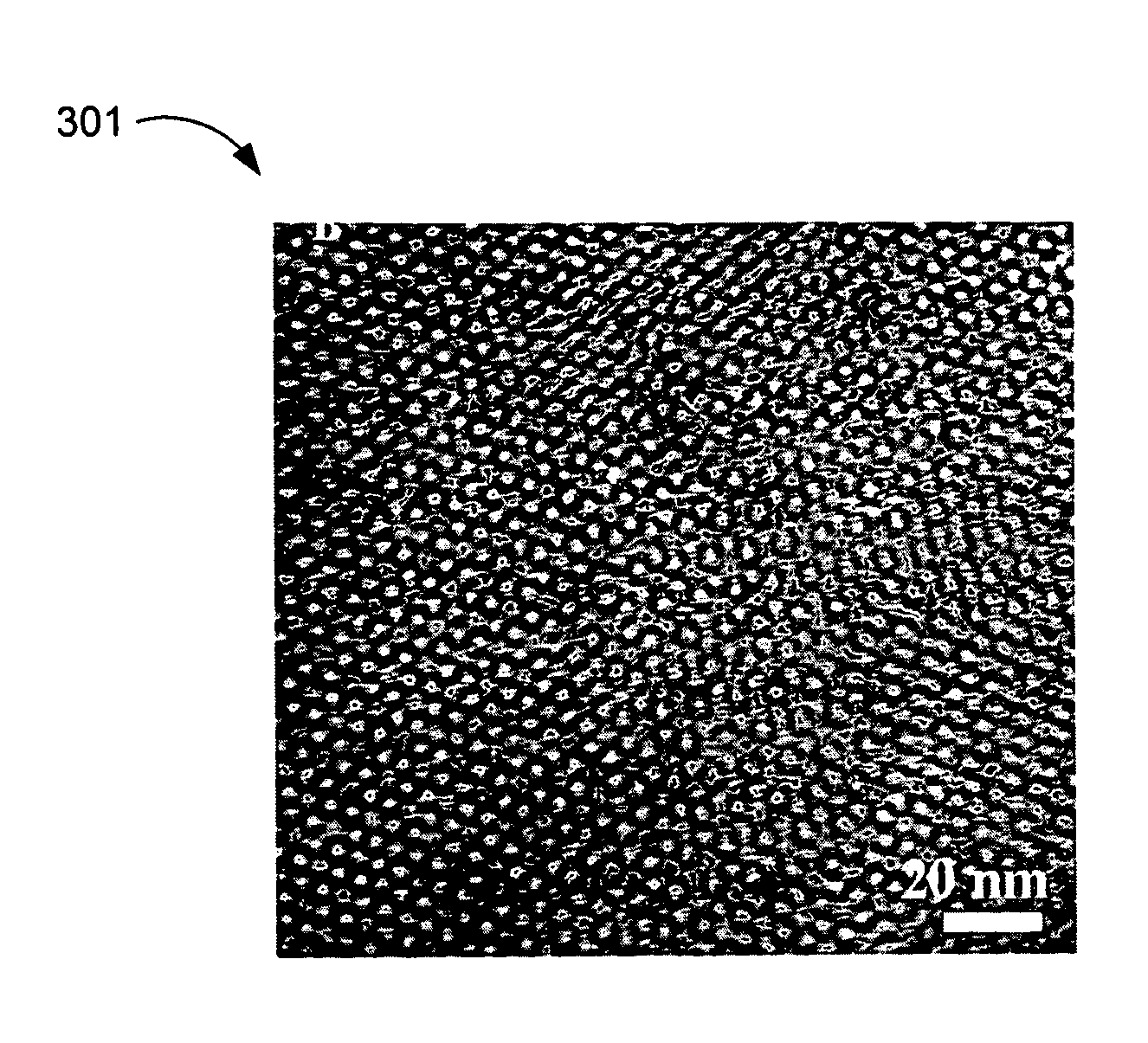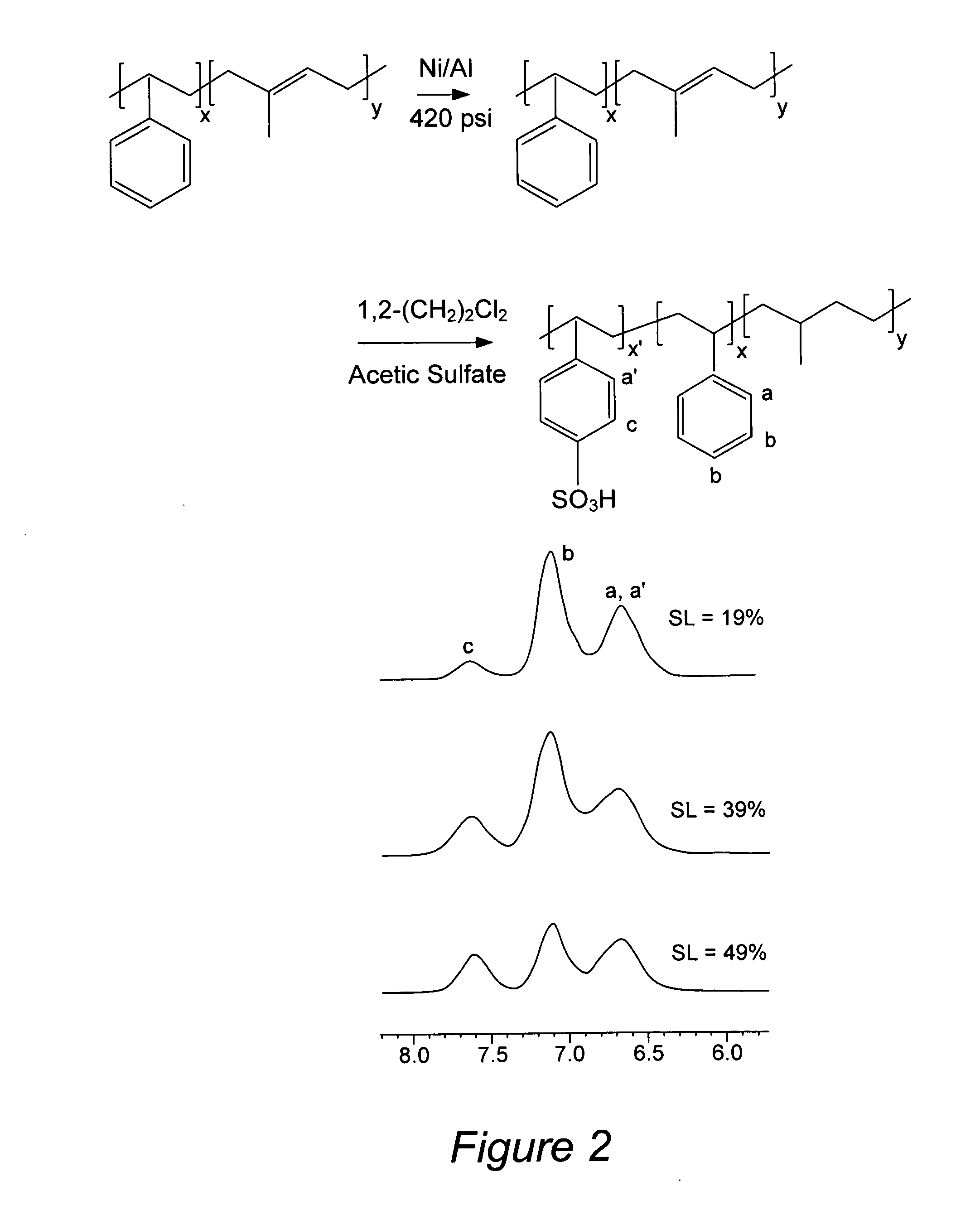[0010]Conventionally used PEM polymers, such as sulfonated perfluoroalkyl polymers sold under
NAFION®
trademark (DuPont de Nemours), are prone to water loss at temperatures greater than 60° C. In these conventional PEMs, water loss is particularly pronounced when the membrane operates under low
relative humidity (RH) conditions, e.g. at an RH of about 50%. Because operation at high RH is not always practical and may require complex water management systems, there is a need for PEM materials which can maintain high
water uptake and high
proton conductivities at high temperatures and under low humidity conditions. Such materials and their methods of preparation are described herein. It is understood that while the described materials are particularly advantageous for PEFCs operating at high temperatures and low RHs, the invention is not limited to these particular conditions or applications. The polymeric materials described herein can be used under a variety of conditions, including operation at low temperatures, and in a variety of applications reaching beyond fuel
cell applications, e.g., as
ion-exchange resins. Another alternative application for the described polymers involves their use in clothing materials to protect the clothes wearer from
dehydration in hot and dry environments. In yet another alternative application, the polymers described herein are used in membranes employed in liquid (e.g., water) purification systems. The small size of the channel within the
polymer may allow for effective removal of impurities from water. When used in
filtration membranes, the described polymers may allow small water molecules to pass through hydrophilic channels, while blocking larger molecules of impurities, or particles. In some aspects, a water purification
system having a membrane comprising a polymer as described herein is provided. Operation of such
system includes filtering water through polymer-containing membrane, such that impurities are blocked by the membrane, while water is allowed to pass through the membrane.
[0017]The membranes having proton conductive channels with widths of less than about 6 nm further possess several advantageous properties which are not encountered in conventionally used membranes. The membranes provided herein can maintain stable conductivities at high temperatures over periods of at least 48 hours. Conventionally used membrane materials, in contrast, often exhibit a relatively
high conductivity when the material is first exposed to high temperature but the
conductivity significantly decreases over time of
exposure. Such
instability of
conductivity is disadvantageous for fuel
cell applications. The membranes provided herein address this problem. An additional desirable feature of membrane materials described herein is that some of these materials are capable of entraining (e.g., absorbing or retaining) a greater amount of water at higher temperature than at a lower temperature. Accordingly, one aspect of the invention provides a PEM comprising a block
copolymer having hydrophilic channels, wherein the PEM entrains a greater amount of water at a higher temperature than at a lower temperature. The membranes exhibit this unusual behavior at a constant RH value and in the absence of any external treatments or membrane modifications. Retention of greater amounts of water at higher temperatures further enhances the proton
conductivity of membranes at higher temperatures.
[0020]In some embodiments, the PEMs provided herein include a cross-linked polymer. For example, a hydrophilically functionalized block
copolymer having a plurality of hydrophilic channels, wherein at least some channels have widths of less than about 6 nm, may include cross-links (e.g., S—S bonds or C—C bonds) between or within individual polymer chains. Cross-linked polymers can improve mechanical properties of the membranes, providing more robust PEMs. In some embodiments, it is preferable to introduce cross-links within the hydrophobic portions of a block-
copolymer, without making cross-links within hydrophilic channels. Cross-linking the hydrophobic block in this manner can improve mechanical properties of the polymer without affecting the proton conductivity of the hydrophilic channels. Methods for selectively cross-linking hydrophobic block in the presence of a hydrophilic block are known to those of skill in the art. For example, cross-linking agents that are selective for chemical bonds within the hydrophobic block may be used. Specifically, when hydrophilic block includes hydrophilically functionalized aromatic moieties, and hydrophobic block includes non-aromatic moieties, S—S and C—C cross-links can be selectively formed within the hydrophobic block by treating the polymer with a cross-linking agent that derivatizes non-aromatic moieties, but leaves aromatic groups intact. For example C—C cross links can be selectively formed within the hydrophobic block containing non-aromatic moieties by treating the polymer with an
electron beam.
 Login to View More
Login to View More 


